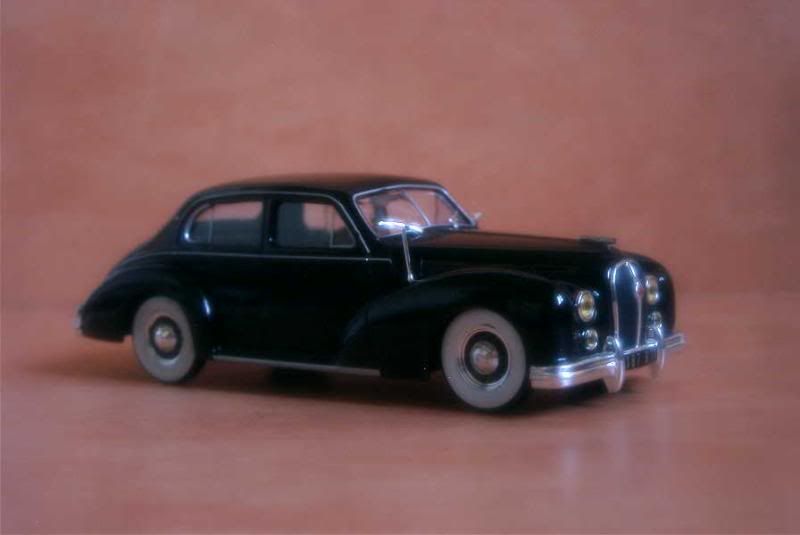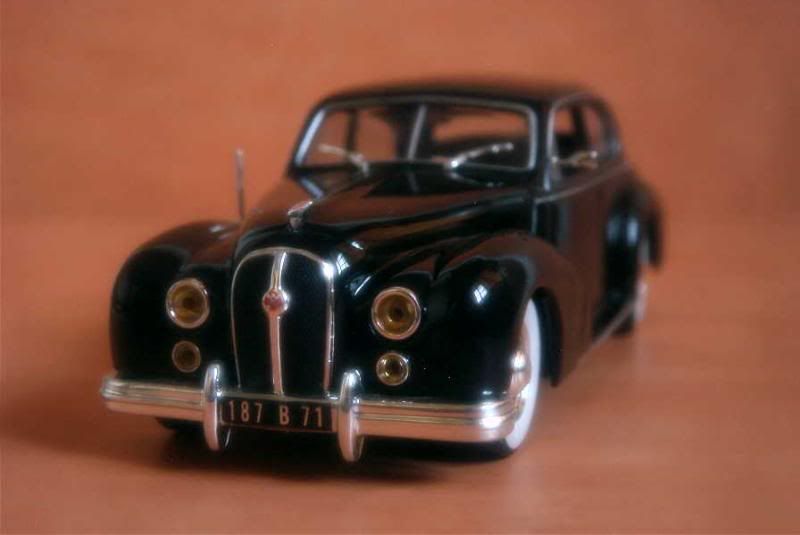A little history
Though one step below companies such as Delage, Delahaye or Talbot on the luxury ladder, Hotchkiss was nonetheless agonizing as well as those by 1950. During that year, it introduced a seemingly new model, the Anjou, a large saloon that was actually a pontoon-bodied version of its pre-war chassis with unchanged four- or six-cylinder engines. Actually, the Anjou should have never seen light if Hotchkiss’ plans had run smoothly.
In 1948, Hotchkiss had agreed to build Jean-Albert Grégoire’s project for an advanced front-wheel-drive saloon. This wasn’t the first time the old company would collaborate with the famous engineer, who had also created the Compound, sold by Amilcar after this company had been taken over by Hotchkiss. This Compound wasn’t necessarily a good souvenir. Its advanced design had proved too hard to be produced in large quantities (it was virtually impossible to cast two identical pieces of its intricate structure in light alloy: they should be corrected and adjusted by hand in order to fit, making the construction time-consuming and expensive). Furthermore, Grégoire was extremely difficult to work with. If it is true that all great minds are egocentrics and megalomaniacs, then the engineer certainly was a genius.
Well, some people never learn.
As we said, Hotchkiss agreed to build the Grégoire car… which again proved impossible to produce in the quantities and for the cost that were expected. Production was so much delayed that an interim Hotchkiss model was needed – hence the birth of the Anjou. As it turned out, the latter would both outsold and outlive the Grégoire.
In 1955, the Anjou wasn’t far from being antiquated. Although ageing, its body still had some class, but on the road it unmistakably behaved like a car from another time. After the Grégoire’s failure, Hotchkiss was now in a hopeless situation. A decision was made to stop the construction of passenger cars, after fifty-two years of production. Instead, Hotchkiss would build Jeeps for the French market – a deal with Willys was certainly less problematic than one with Grégoire!
Fulfilling orders for the French army and a few administrations, notably the firefighters, kept Hotchkiss busy for a few more years, but the company never succeeded in selling large numbers of jeeps to the public – in France as anywhere else, civilians would turn to cheap army surpluses rather than buy an expensive new model. The last jeeps rolled out the production line in 1967.
About the model
Model: Hotchkiss Anjou
Year: 1950
Maker: Ixo
Scale: 1/43
Distributed by: Altaya as no.52 of its Nos Chères Voitures d'Antan press series
Acquired: brand new, in May 2006, in Souillac, France
Ixo’s rendition of the Hotchkiss Anjou fells once again in the “slightly above average” bracket with which the Chinese brand is accustomed. Its model is correct, but doesn’t offer anything to be truly ecstatic about. I think that it could possibly have done without an antenna or a mirror, this kind of accessories still being rarities in 1950 (I suppose that Ixo based its model on a 1:1 collector’s car retrofitted with everything imaginable, and therefore not really representative of the way the car looked when new). My rating is 13/20, as for its lack of genuine qualities this die-cast has few flaws either.


Though one step below companies such as Delage, Delahaye or Talbot on the luxury ladder, Hotchkiss was nonetheless agonizing as well as those by 1950. During that year, it introduced a seemingly new model, the Anjou, a large saloon that was actually a pontoon-bodied version of its pre-war chassis with unchanged four- or six-cylinder engines. Actually, the Anjou should have never seen light if Hotchkiss’ plans had run smoothly.
In 1948, Hotchkiss had agreed to build Jean-Albert Grégoire’s project for an advanced front-wheel-drive saloon. This wasn’t the first time the old company would collaborate with the famous engineer, who had also created the Compound, sold by Amilcar after this company had been taken over by Hotchkiss. This Compound wasn’t necessarily a good souvenir. Its advanced design had proved too hard to be produced in large quantities (it was virtually impossible to cast two identical pieces of its intricate structure in light alloy: they should be corrected and adjusted by hand in order to fit, making the construction time-consuming and expensive). Furthermore, Grégoire was extremely difficult to work with. If it is true that all great minds are egocentrics and megalomaniacs, then the engineer certainly was a genius.
Well, some people never learn.
As we said, Hotchkiss agreed to build the Grégoire car… which again proved impossible to produce in the quantities and for the cost that were expected. Production was so much delayed that an interim Hotchkiss model was needed – hence the birth of the Anjou. As it turned out, the latter would both outsold and outlive the Grégoire.
In 1955, the Anjou wasn’t far from being antiquated. Although ageing, its body still had some class, but on the road it unmistakably behaved like a car from another time. After the Grégoire’s failure, Hotchkiss was now in a hopeless situation. A decision was made to stop the construction of passenger cars, after fifty-two years of production. Instead, Hotchkiss would build Jeeps for the French market – a deal with Willys was certainly less problematic than one with Grégoire!
Fulfilling orders for the French army and a few administrations, notably the firefighters, kept Hotchkiss busy for a few more years, but the company never succeeded in selling large numbers of jeeps to the public – in France as anywhere else, civilians would turn to cheap army surpluses rather than buy an expensive new model. The last jeeps rolled out the production line in 1967.
About the model
Model: Hotchkiss Anjou
Year: 1950
Maker: Ixo
Scale: 1/43
Distributed by: Altaya as no.52 of its Nos Chères Voitures d'Antan press series
Acquired: brand new, in May 2006, in Souillac, France
Ixo’s rendition of the Hotchkiss Anjou fells once again in the “slightly above average” bracket with which the Chinese brand is accustomed. Its model is correct, but doesn’t offer anything to be truly ecstatic about. I think that it could possibly have done without an antenna or a mirror, this kind of accessories still being rarities in 1950 (I suppose that Ixo based its model on a 1:1 collector’s car retrofitted with everything imaginable, and therefore not really representative of the way the car looked when new). My rating is 13/20, as for its lack of genuine qualities this die-cast has few flaws either.





No comments:
Post a Comment